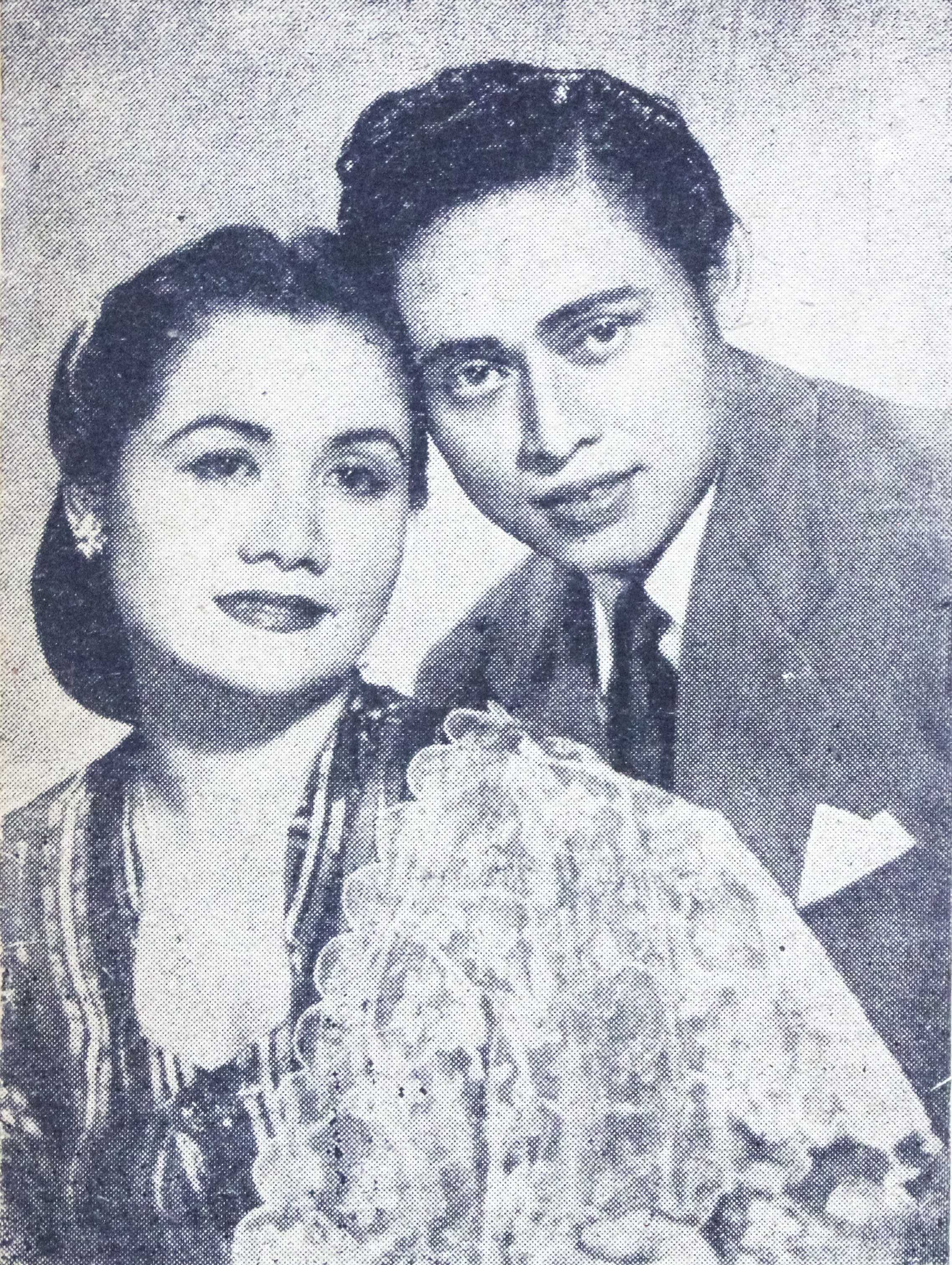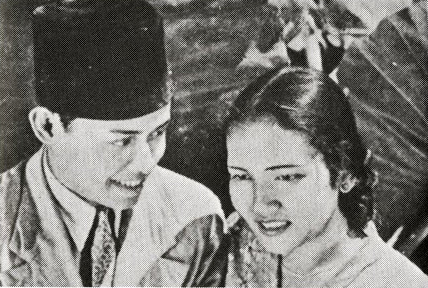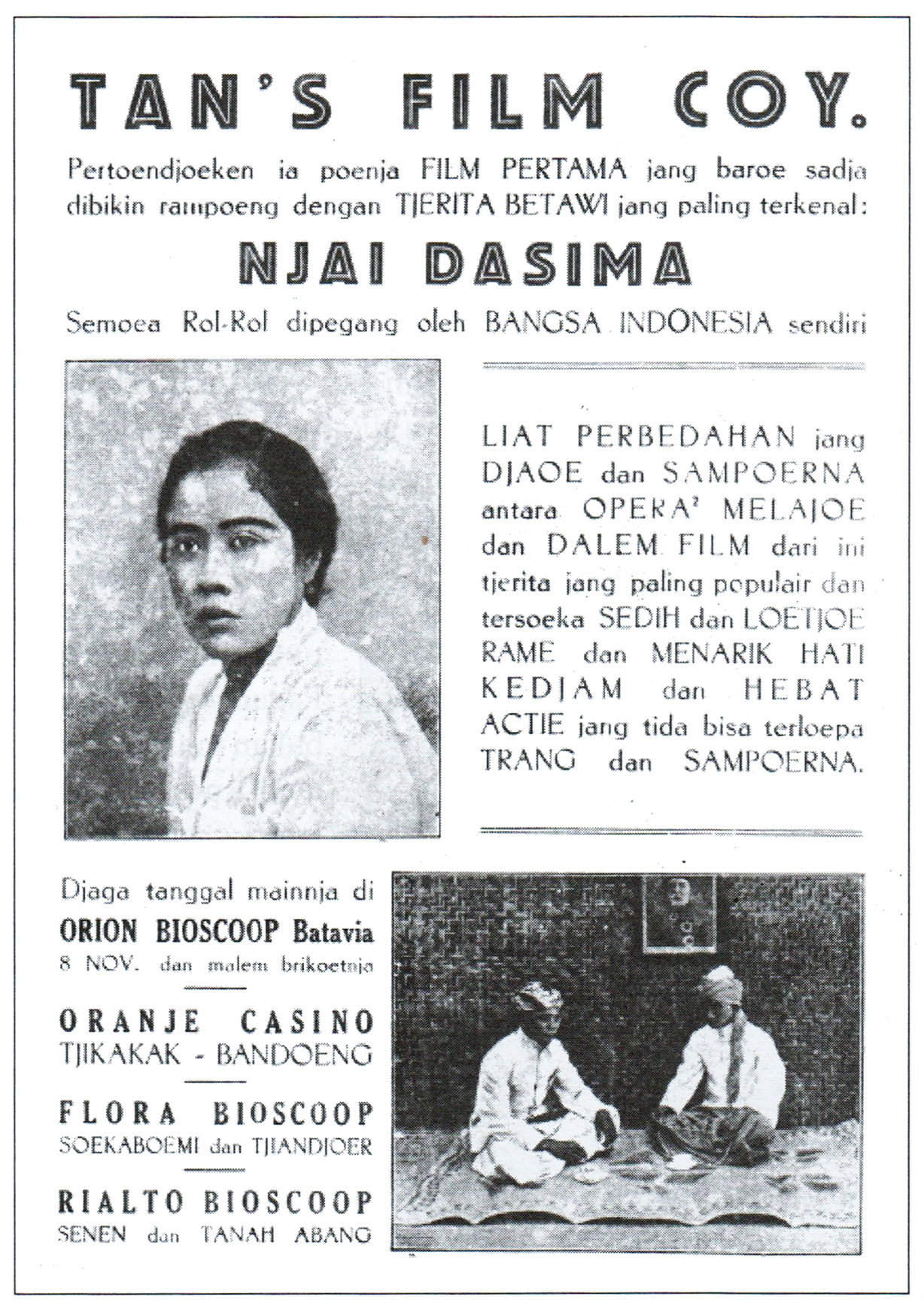|
Kedok Ketawa
''Kedok Ketawa'' (; Indonesian for ''The Laughing Mask'', also known by the Dutch title ''Het Lachende Masker'') is a 1940 action film from the Dutch East Indies (now Indonesia). Union Films' first production, it was directed by Jo An Djan. Starring Basoeki Resobowo, Fatimah, and Oedjang, the film follows a young couple who fight off criminals with the help of a masked man. Advertised as an "Indonesian cocktail of violent actions ... and sweet romance", ''Kedok Ketawa'' received positive reviews, particularly for its cinematography. Following the success of the film, Union produced another six works before being shut down in early 1942 during the Japanese occupation. The film, screened until at least August 1944, may be lost. Plot In Cibodas, Banten, a young woman named Minarsih (Fatimah) is rescued from four thugs by the painter Basuki ( Basoeki Resobowo). They fall in love and begin planning their life together. However, a rich man interested in taking Minarsih to ... [...More Info...] [...Related Items...] OR: [Wikipedia] [Google] [Baidu] |
Surabaya
Surabaya ( jv, ꦱꦸꦫꦧꦪ or jv, ꦯꦹꦫꦨꦪ; ; ) is the capital city of the Provinces of Indonesia, Indonesian province of East Java and the List of Indonesian cities by population, second-largest city in Indonesia, after Jakarta. Located on the northeastern border of Java island, on the Madura Strait, it is one of the earliest port cities in Southeast Asia. According to the Government of Indonesia, National Development Planning Agency, Surabaya is one of the Regions of Indonesia#Development regions, four main central cities of Indonesia, alongside Jakarta, Medan, and Makassar. The city has a population of 2.87 million within its city limits at the 2020 census and 9.5 million in the extended Surabaya metropolitan area, making it the List of metropolitan areas in Indonesia, second-largest metropolitan area in Indonesia. The city was settled in the 10th century by the Janggala, Kingdom of Janggala, one of the two Javanese kingdoms that was formed in 1045 when ... [...More Info...] [...Related Items...] OR: [Wikipedia] [Google] [Baidu] |
Priyayi
''Priyayi'' (former spelling: ''Prijaji'') was the Dutch East Indies, Dutch-era class of the nobles of the robe, as opposed to royal nobility or ''ningrat'' (Javanese language, Javanese), in Java, Indonesia, the List of islands by population, world's most populous island. ''Priyayi'' is a Javanese word originally denoting the descendants of the ''adipati'' or governors, the first of whom were appointed in the 17th century by the Sultan Agung of Mataram to administer the principalities he had conquered. Initially court officials in pre-colonial kingdoms, the ''priyayi'' moved into the colonial civil service and then on to administrators of the modern Indonesian republic. Pre-colonial period The Mataram Sultanate, an Islamic polity in south central Java that reached its peak in the 17th century, developed a Kraton (Indonesia), ''kraton'' ("court") culture from which the Sultan emerged as a charismatic figure that rules over a relatively independent aristocracy. Named ''para yay ... [...More Info...] [...Related Items...] OR: [Wikipedia] [Google] [Baidu] |
Pemandangan
''Pemandangan'' was a daily Indonesian language newspaper published in the Dutch East Indies (or later Indonesia) between 1933 and 1958. It was one of the few local newspapers which was initially allowed to operate during the Japanese occupation of the Dutch East Indies. History The newspaper was first published on 8 April 1933 by journalist Saeroen. In the first few months after the first issue, the sales of the newspaper could not cover expenditures, and the newspaper received financial support from local plantation owner Oene Djoenaidi. Saeroen would write editorials in ''Pemandangan'' under the pen name "Kampret" (bat), but these editorials resulted in ''Pemandangan'' being censored by the Dutch East Indies government. It also ceased publication for a week between 17 and 24 May 1940, due to censorship. ''Pemandangan'' would continue to publish following the Japanese invasion of the Dutch East Indies, and was the only newspaper to continue publication during the early occupatio ... [...More Info...] [...Related Items...] OR: [Wikipedia] [Google] [Baidu] |
Kroncong
Kroncong (pronounced "kronchong"; id, Keroncong, nl, Krontjong) is the name of a ukulele-like instrument and an Indonesian musical style that typically makes use of the kroncong (the sound ' comes from this instrument, so the music is called ''kroncong''). A ''kroncong'' orchestra or ensemble traditionally consists of a flute, a violin, at least one, but usually a pair of ''kroncongs'', a cello in pizzicato style, string bass in pizzicato style, and a vocalist. ''Kroncong'' originated as an adaptation of a Portuguese musical tradition, brought by sailors to Indonesian port cities in the 16th century. By the late 19th century, ''kroncong'' reached popular music status throughout the Indonesian archipelago. Characteristics The name "Kroncong" may be derived from the jingling sound of the ''kerincing rebana'', as heard in the rhythmic background of the music created by the interlocking of instruments playing on or off beat. This background rhythm runs faster than the often slow vo ... [...More Info...] [...Related Items...] OR: [Wikipedia] [Google] [Baidu] |
Srigala Item
''Srigala Item'' (Indonesian for ''Black Wolf'', also advertised with the Dutch title ''De Zwarte Wolf'') is a 1941 film from the Dutch East Indies that was directed by Tan Tjoei Hock and produced by The Teng Chun for Action Film. Starring Hadidjah, Mohamad Mochtar, and Tan Tjeng Bok, the film's plot – inspired by Zorro – follows a young man who became a masked vigilante to take revenge against his conniving uncle. ''Srigala Item'' was a commercial success, which Misbach Yusa Biran credits to the plot's use for escapism. A copy of the black-and-white film, which featured ''kroncong'' music, is stored at Sinematek Indonesia. Plot Through violence, Djoekri (Tan Tjeng Bok) is able to gain control of his brother Mardjoeki's (Bissoe) wealth and plantation, Soemberwaras. The latter disappears, leaving behind his adult son Mochtar (Mohamad Mochtar). At the plantation, the young man is treated as a servant and often beaten by Djoekri and his right-hand man, Hasan. Djoekri's ... [...More Info...] [...Related Items...] OR: [Wikipedia] [Google] [Baidu] |
Rd Mochtar
Hajji Raden Mochtar (born 1918), often credited as Rd Mochtar, was an Indonesian actor. Of noble descent, Mochtar was discovered by Albert Balink and first cast in the commercial failure ''Pareh'' (1936). Rising to popularity after the release of ''Terang Boelan'' the following year, he spent nearly sixty years in film, while also becoming a businessman and farmer. Childhood and early career Mochtar was born in Cianjur, West Java, in 1918. He was a Javanese of ''priyayi'' (noble) descent. He did his elementary school studies at a Taman Siswa school in Bandung. In 1935 Mochtar was cast in the leading role of Mahmud in Albert Balink's film ''Pareh''. Balink was out with coffee with Joshua and Othniel Wong and saw Mochtar, whom he considered tall, strong, and handsome, driving by. Balink and the Wongs chased Mochtar in their car and caught him. For the film Mochtar was told to use the title ''Raden'', which he and his family had already abandoned. According to the Indonesian a ... [...More Info...] [...Related Items...] OR: [Wikipedia] [Google] [Baidu] |
Gagak Item
''Gagak Item'' (; Vernacular Malay for ''Black Raven'', also known by the Dutch title ''De Zwarte Raaf'') is a 1939 bandit film from the Dutch East Indies (now Indonesia) directed by Joshua and Othniel Wong for Tan's Film. Starring Rd Mochtar, Roekiah, and Eddy T. Effendi, it follows a masked man known only as "Gagak Item" ("Black Raven"). The black-and-white film, which featured the cast and crew from the 1937 hit ''Terang Boelan'' (''Full Moon''), was a commercial success and received positive reviews upon release. It is likely lost. Production ''Gagak Item'' was directed by brothers Joshua and Othniel Wong; filming the work in black-and-white, they also handled sound editing. It was produced by Tan Khoen Yauw of Tan's Film and starred Rd Mochtar, Roekiah, Eddy T. Effendi, and Kartolo. The Wongs and cast had first worked together on Albert Balink's 1937 blockbuster ''Terang Boelan'' (''Full Moon''), before joining Tan's Film in 1938 for the highly successful '' Fatima' ... [...More Info...] [...Related Items...] OR: [Wikipedia] [Google] [Baidu] |
Tan's Film
Tan's Film was a film production house in the Dutch East Indies (modern Indonesia). Established by the brothers Tan Khoen Yauw and Tan Khoen Hian on September 1, 1929, its films were mostly targeted at native ethnic groups. Starting with '' Njai Dasima'' in 1929, the company released fifteen movies before ultimately being dissolved after the Japanese occupation. The Tans and the Wong brothers established Tan & Wong Bros in 1948 to continue this work. History First iteration Tan's Film Company was established by Tan Khoen Yauw and his brother Tan Khoen Hian on September 1, 1929. It was one of three studios established in the Dutch East Indies that year, together with Nansing Film Corporation and another Chinese-owned studio. Tan's established a large studio building on Defensielijn v.d. Bosch (now Bungur Besar Raya Street). It had several divisions, including costuming, filming, and decor. The Tans, who had been raised in Kwitang, Batavia (modern day Jakarta) and grown up in ... [...More Info...] [...Related Items...] OR: [Wikipedia] [Google] [Baidu] |
Dracula (1931 English-language Film)
''Dracula'' is a 1931 American pre-Code supernatural horror film directed and co-produced by Tod Browning from a screenplay written by Garrett Fort and starring Bela Lugosi in the titular role. It is based on the 1924 stage play ''Dracula'' by Hamilton Deane and John L. Balderston, which in turn is adapted from the 1897 novel ''Dracula'' by Bram Stoker. Lugosi portrays Count Dracula, a vampire who emigrates from Transylvania to England and preys upon the blood of living victims, including a young man's fiancée. Produced and distributed by Universal Pictures, ''Dracula'' is the first sound film adaptation of the Stoker novel. Several actors were considered to portray the title character, but Lugosi, who had previously played the role on Broadway, eventually got the part. The film was partially shot on sets at Universal Studios Lot in California, which were reused at night for the filming of ''Dracula'', a concurrently produced Spanish-language version of the story also by Univer ... [...More Info...] [...Related Items...] OR: [Wikipedia] [Google] [Baidu] |
Dracula
''Dracula'' is a novel by Bram Stoker, published in 1897. As an epistolary novel, the narrative is related through letters, diary entries, and newspaper articles. It has no single protagonist, but opens with solicitor Jonathan Harker taking a business trip to stay at the castle of a Transylvanian nobleman, Count Dracula. Harker escapes the castle after discovering that Dracula is a vampire, and the Count moves to England and plagues the seaside town of Whitby. A small group, led by Abraham Van Helsing, hunt Dracula and, in the end, kill him. ''Dracula'' was mostly written in the 1890s. Stoker produced over a hundred pages of notes for the novel, drawing extensively from Transylvanian folklore and history. Some scholars have suggested that the character of Dracula was inspired by historical figures like the Wallachian prince Vlad the Impaler or the countess Elizabeth Báthory, but there is widespread disagreement. Stoker's notes mention neither figure. He found the name ''D ... [...More Info...] [...Related Items...] OR: [Wikipedia] [Google] [Baidu] |
Bram Stoker
Abraham Stoker (8 November 1847 – 20 April 1912) was an Irish author who is celebrated for his 1897 Gothic horror novel '' Dracula''. During his lifetime, he was better known as the personal assistant of actor Sir Henry Irving and business manager of the Lyceum Theatre, which Irving owned. In his early years, Stoker worked as a theatre critic for an Irish newspaper, and wrote stories as well as commentaries. He also enjoyed travelling, particularly to Cruden Bay where he set two of his novels. During another visit to the English coastal town of Whitby, Stoker drew inspiration for writing ''Dracula''. He died on 20 April 1912 due to locomotor ataxia and was cremated in north London. Since his death, his magnum opus ''Dracula'' has become one of the most well-known works in English literature, and the novel has been adapted for numerous films, short stories, and plays. Early life Stoker was born on 8 November 1847 at 15 Marino Crescent, Clontarf, on the northside of Dubli ... [...More Info...] [...Related Items...] OR: [Wikipedia] [Google] [Baidu] |
Cinema Of The United States
The cinema of the United States, consisting mainly of major film studios (also known as Hollywood) along with some independent film, has had a large effect on the global film industry since the early 20th century. The dominant style of American cinema is classical Hollywood cinema, which developed from 1913 to 1969 and is still typical of most films made there to this day. While Frenchmen Auguste and Louis Lumière are generally credited with the birth of modern cinema, American cinema soon came to be a dominant force in the emerging industry. , it produced the third-largest number of films of any national cinema, after India and China, with more than 600 English-language films released on average every year. While the national cinemas of the United Kingdom, Canada, Australia, and New Zealand also produce films in the same language, they are not part of the Hollywood system. That said, Hollywood has also been considered a transnational cinema, and has produced multiple lan ... [...More Info...] [...Related Items...] OR: [Wikipedia] [Google] [Baidu] |








